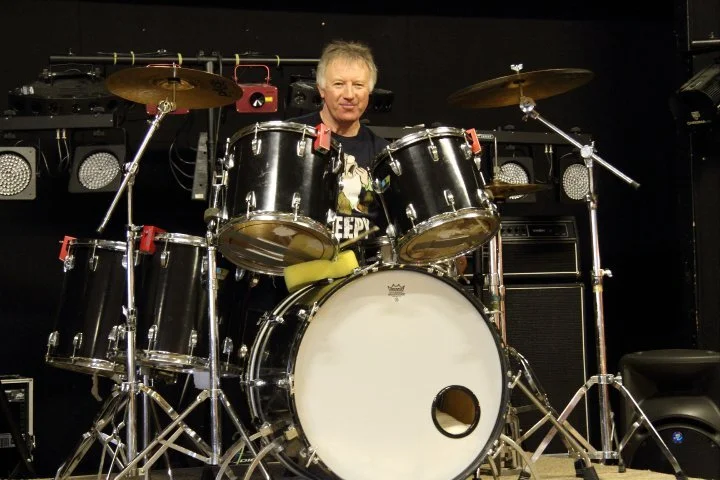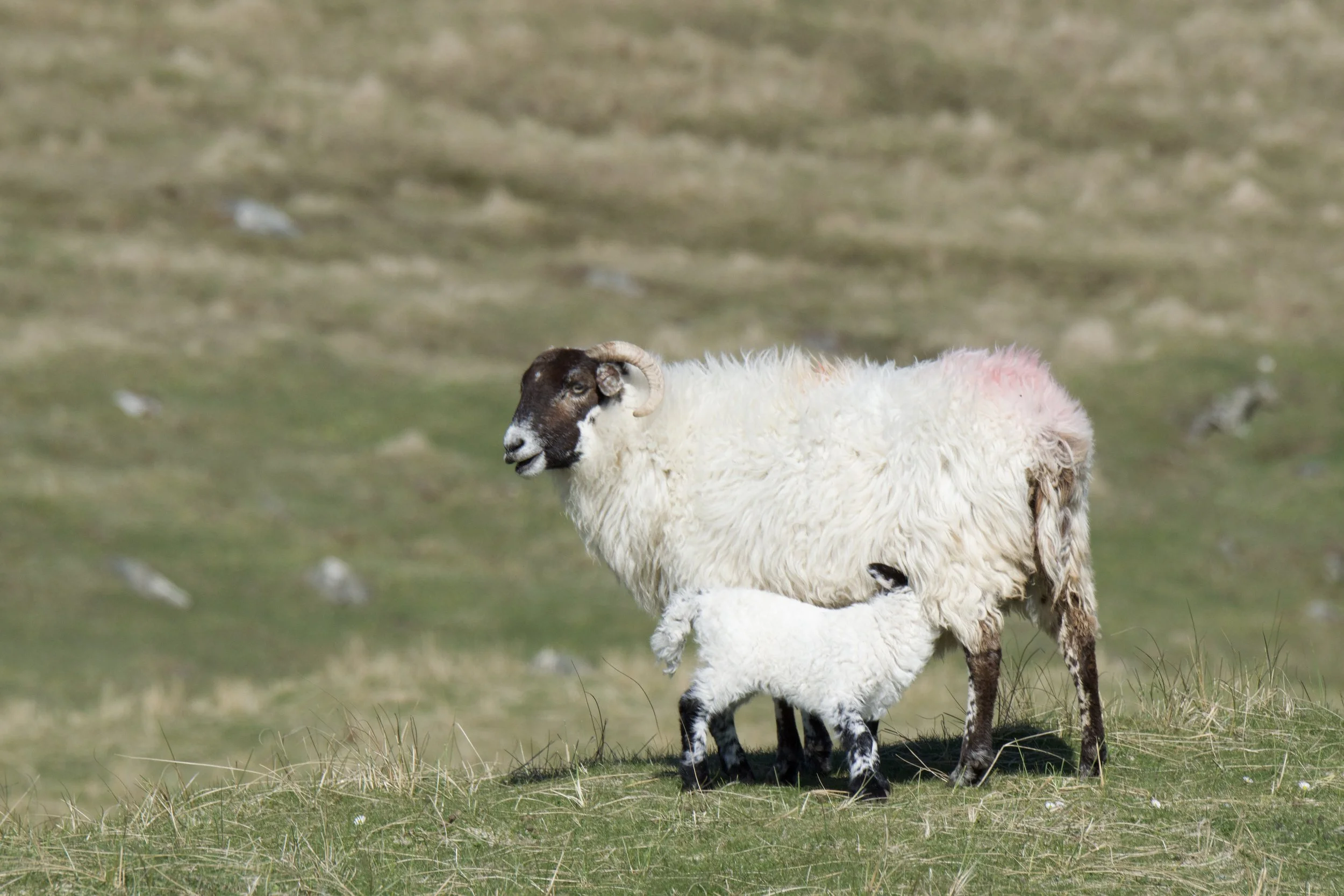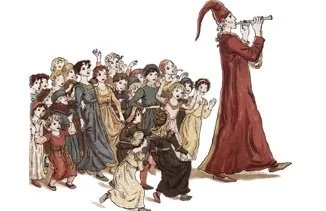‘Pied Drummer’ of Sheriff Muir
A true tale of human tempo, natures rhythm and which influences which.
A perfect example of a top class tempo keeping drummer in action — Photo of Billy Winston by kind permission of UK rock band Winston
Percussion I am assured is the backbone of any musical ensemble. A drummer told me that.
It seems that the percussion section, particularly the drum, is essential to keeping the tempo, because it would appear that the other musicians, particularly the guitar strummers, can’t. A different drummer told me that.
This true tale is not really about bands or groups or other musicians and whether or not they have tempo, it is about sheep, with a comment or two about other ‘rocking’ creatures.
lamb feeding
It is also a truth, according to Cymbal Simon, a different drummer, that girls are attracted to the drums. Not sure how it works if the drummer is a girl, but hey, I don’t have an answer for everything. Live and let live is the motto in the land of the drummer.
He described drums as a ‘chick magnet’, or was that Magnete? I should have asked. I have a sneaking suspicion however that he was not referring to Colonel Sanders.
My first instinct when listening to my friends story was to think, really? I’d better research this. I had a feeling I was getting the wool pulled over my eyes, but the more I listened and read the more I believed.
I will return to sheep and Cymbal Simon shortly, but first, let me take you to a tale involving wild horses.
horses gathering for a rhythm session
A woman called Jill Star ran, perhaps still does, an organisation designed to support and help Native American youths understand and revive their tribal values, culture, ceremony and language. Interaction with wild horses was part of that programme.
Student participants each selected a wild horse and were allowed to assist in its training and “gentling”. One evening the students began to chant and drum around a large camp fire, as their primogenitors had done in the past.
The horses were not part of that experience, that is, until they were.
As the students drummed by the light of the open fire, the wild horses quietly walked in from the darkness of the prairie then stood, calmly watching and listening, as though bewitched.
It was a moving, unforgettable experience for students and staff alike.
Let me now take you back to Scotland, to sheep, to Sheriff Muir near Dunblane, to Simon Pooley, my friend the drummer and his van. Simon, otherwise known as Cymbal, was due to accompany American Blues singer, Jimmy Reid on his European tour. In earlier years Simon had drummed for Kevin Montomery, son of Bob Montgomery, the latter famously having written songs for Buddy Holly, Billy Fury and Cliff Richard, amongst others.
In preparation, Simon was practicing in his garage. But things were not going well. His close neighbours were not totally ‘at one’ with his percussive talents, particularly the incessant thumping, rat-a-tatting and pit-a-patting emanating from his abode.
Their retaliatory, unrhythmical bang-banging on his garage door, was a clue to their feelings and definitely not helpful to Simon’s rhythm.
There was only one solution. He stowed his drum kit safely in his van and headed into a quiet corner of the Stirlingshire countryside. Quiet until he arrived that is. The quiet corner I refer to was Sheriff Muir, on the south west flank of the Ochil Hills.
Our drummer, now freed from his unappreciative audience, let his frustrations out on his unsuspecting drum kit. With eyes closed and in a pleasure trance, our hero beat himself into a crescendo of noise and sweat for the best part of two hours.
I think that describes what he did, although on re reading it, I am not sure it sounds very savoury.
Anyway, when finished and in the process of coming down from the non chemical high he had transported himself to, he became aware of someone banging on the side of his van. He opened the door, expecting to see an angry face or perhaps a black and white ‘chequered hat’, illuminated by blue flashing lights. He was somewhat surprised therefore to see the local shepherd and the land owner standing outside the van.
‘I am really sorry if I have disturbed you,’ stuttered Simon.
‘No need to apologise, no need at all. In fact we are wondering if you will come back next week at this time?’
‘Sorry, I don’t understand, back next week? Why?’
‘Have a look outside, look at all the sheep?’
‘The sheep?’
‘Aye, have a look.’
To our drummer’s surprise there were two hundred or more sheep clustered against the fence adjacent to where he was parked, all staring at his van. Seems they were displaying more enthusiasm for his drumming skills than his neighbours had.
‘So will you be back next week?’
‘If you like, but why?’
‘Well we will be gathering the sheep, for the annual dipping and shearing. They are spread all over the hill and our dogs can take most of the day to get them gathered. If you just park in the same place and do what you were doing today, it will save us hours.’
And he did just that and the sheep responded exactly as expected and the gathering was achieved in jig time. Our hero’s trouble was rewarded to the tune of £50. A good day all round.
So there you have it, sheep on Sheriffmuir and wild horses in the USA, entranced by the rhythm of the drum.
sheriff muir sheep flocking to hear our ‘pied’ drummer
In 2001, researchers at the University of Leicester played music to herds of Friesian dairy cows. The called it the ‘Moosic Study’. They found that calming music, for example; R.E.M.’s “Everybody Hurts,” Simon & Garfunkel’s “Bridge Over Troubled Water,” and Beethoven’s “Pastoral Symphony” resulted in the cows producing 3 percent more milk.
It is claimed that the study of animal musicality probably goes back Charles Darwin. He noted that rhythm is everywhere in the biological world, leading naturally to the rise of music.
Is it not also the case that Bob Dylan echoed Darwin’s thoughts in his beautiful song, ‘Lay Down Your Weary Tune’, in which he refers to the ‘Drums of Dawn’.
There are many other examples of animals reacting to ‘rhythm’. I will stick to just two
In 2009, when Patel, Iverson, Bregman and Schulz were studying animals and their reaction to music they observed Snowball, a Cockatoo, dancing to “Everybody” by the Backstreet Boys. They played the song at different tempos and Snowball continued to confound them by matching his head bobs and other movements to the different beats. He also danced to different Michael Jackson songs.
In a different study, contained in the Journal of Comparative Psychology, 2013, Cook, Rouse, Wilson and Reichmuth, commented on the the gyrations of a California Sea Lion, bobbing its head to “Boogie Wonderland”.
Ronan the Sea Lion and Snowball the Cockatoo, it seems have been compared to the creatures version of Baryshnikov the ballet dancer.
So there you have it; animals have been observed Rocking and Bopping to both music and drum and the conclusion is;
they have rhythm.
Did the rats of Hamelin also have rhythm and perhaps a bit of Reggie or Ska when they merrily bopped along behind the Pied Piper to their ignominious end, and what enticed the children to follow after the greedy Mayor refused to Pay the Piper?
As illustrated in this small snippet from Browning’s poem of that event from 1284, long before Darwin and Dylan.
From street to street he piped advancing,
And step for step they followed dancing.
Pied Piper of Hamelin leading the children away — Illustration from Pixabay
The street where the children disappeared is now called “The Pied Piper’s Street,” and music is forbidden. It will forever remain a mystery.
As for the Sheriff Muir sheep, they were last seen dancing to a rhythm of their own making as they pranced and frolicked back up into their hillside, to be gathered another day. ian mcneish




